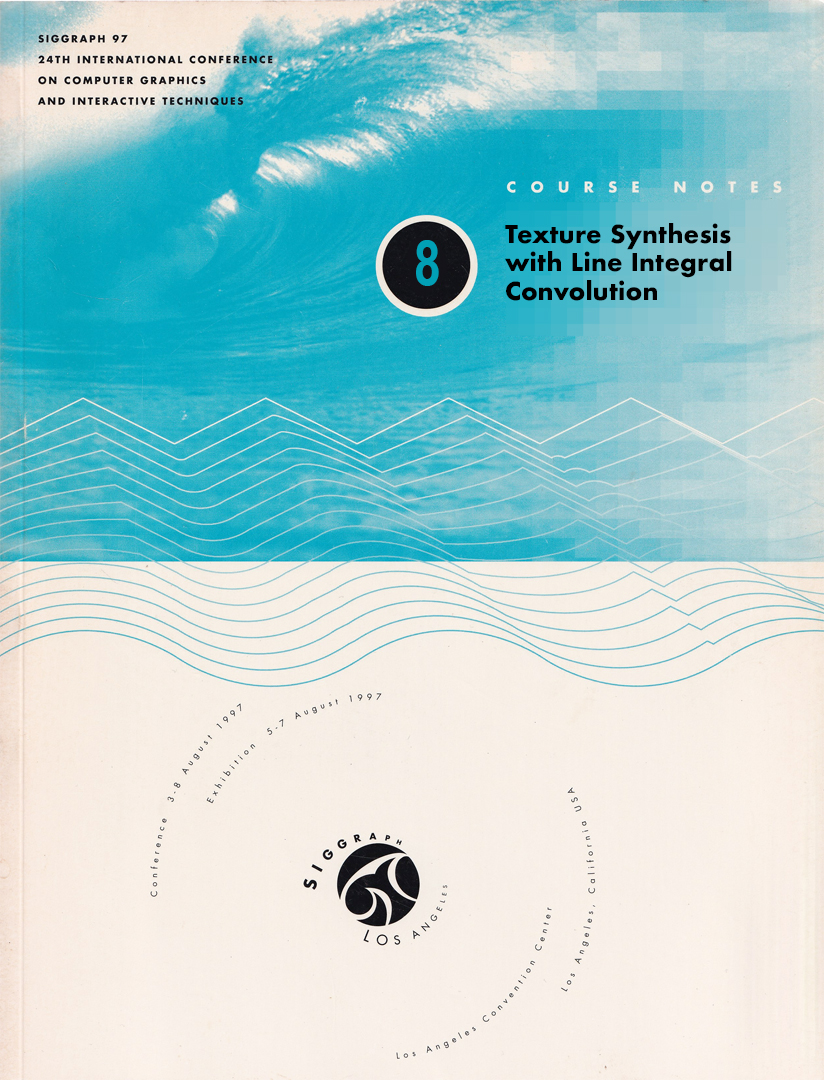“Texture Synthesis with Line Integral Convolution” by Ma, Cabral, Hege, Stalling and Interrante
Conference:
Type(s):
Entry Number: 08
Title:
- Texture Synthesis with Line Integral Convolution
Course Organizer(s):
Presenter(s)/Author(s):
Abstract:
Description
We have seen striking, realistic images made with synthetic textures for 3d graphics, visualization and special effects. The use of synthesized textures has recently gained increasing popularity because more elaborated, powerful techniques are being developed and may be applied to application problems in an economical manner. The Line Integral Convolution (LIC) method introduced by Brian Cabral and Casey Leedom [2] is a particularly powerful and elegant texture synthesis algorithm for visualizing motion and shape. LIC transforms vector data into lively visualization by distorting an input texture image according to the local vector field.
Cabral and Leedom’s creation has inspired many visualization researchers. Forssell [3, 4] extends LIC to vector fields on the curvilinear grids used in computational fluid dynamics simulations. Stalling and Hege develop a fast and resolution independent LIC algorithm that is an order of magnitude faster than the original implementation [13]. Both Cabral/Leedom [1] and Stalling/Zockler/Hege [14] also investigate how to parallelize the LIC calculations to achieve real-time visualization. Kiu and Banks show how the use of multi-frequency noise texture images may enhance a user’s perception of the features in the vector How [8]. Wegenkittl, Gröller and Purgathofer add orientation information to still LIC images [16].
Shen, Johnson and Ma show how to integrate the LIC algorithm into direct volume rendering to construct multiple semi-transparent surfaces and to simulate the use of dye advection in experimental flow visualization [12]. Okada and Kao develop an enhancement technique especially for highlighting flow separation and reattachment boundaries in flow fields defined in 30 curvilinear multi-block grids [10]. To apply LIC to arbitrary 30 polygonal surfaces, Battke, Stalling and Hege come out with an efficient local texture algorithm [5], while Mao, et al. use a view-dependent approach to generate more accurate results [9].
More recently, Interrante experiments with the idea of using the LIC method to illustrate the shape of arbitrary surfaces [6]. She also investigates perceptual issues in visualizing three-dimensional How data [7]. Wegenkittl and Gröller design an approximated version of their oriented LIC algorithm to allow very fast visualization [15]. Shen and Kao are currently developing a new algorithm for handling time-varying data in a more physically correct manner [11].
The continuous, intensive effort by various researchers has made LIC now practical for many applications. Therefore, we believe a course on the LIC method is appropriate and will greatly benefit the users of 3d graphics and visualization technology. This course provides a comprehensive presentation of the LIC techniques. You will learn about the core algorithm and why it works. You will also learn how to implement the algorithms efficiently and how certain key parameters control the intended visual effects. You will be exposed to various application problems through many visual examples including videos and live demonstrations. At the end of the course, you should be able to apply LIC to your application problems by modifying the computer source programs provided by the lecturers.
The lectures contain three parts: the basic algorithm, the optimized algorithms and the extended algorithms. Brian Cabral will talk about the history and motivation of LIC and give an overview of the basic algorithm. This lecture will provide you with the needed background to follow the material covered in the rest of the course.
Next, Hans-Christian Hege and Detlev Stalling will talk about their optimized LIC algorithms and how the LIC calculations may be parallelized to achieve interactive vector field visualization. They will also describe how to perform LICon arbitrary surfaces by converting the surfaces into triangular meshes.
Then, Victoria Interrante will describe how LIC can be applied to visualization of surface shape to generate non-photorealistic scientific illustrations. She will also address some perception issues with using the LIC method.
Finally, Kwan-Liu Ma will talk about combining LIC and direct volume rendering to visualize vector and scalar volume data in a single visualization, and how to enhance local features in flow-field data by using colors. He will also describe some useful extensions of LIC including the idea of using multi-resolution texture input introduced by Kiu and Banks, the oriented LIC techniques invented by Wegenkittl, Gröller and Goldsteiner, as well as the techniques developed by Shen and Kao for visualizing time-varying data.
We have prepared an implementation of the LIC algorithm and installed it in the Creative Applications Laboratory set up by the conference. In this way you can try out some of the ideas introduced in the lectures to grasp the key concepts more clearly. As the results of applying LIC can vary significantly when the input parameters and texture change, we believe this hand-on experience will be highly rewarding to you. The source code is also made available on-line.
Besides the authors/lecturers, David Banks, E. Groller, Ming-Hoe Kiu, Casey Leedom, and Han- Wei Shen have helped put these notes together. We would especially like to thank Viki Dennis, Barb Helfer, Scott Senften and Stephen Spencer of SIGGRAPH for working closely with us to make possible our course and notes.
Contents/Schedule PDF:
Contributed By:
- Mary Whitton
Location:
- Charles Babbage Institute Archives, University of Minnesota




